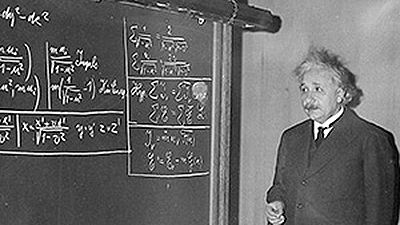Does the Second Law of Thermodynamics Favor Evolution?
Time flies like an arrow. Fruit flies like a banana.
– Groucho Marx
The second law of thermodynamics has long been a topic of discussion in the evolution/creation debate. What is the second law of thermodynamics? Let us start with the first law of thermodynamics—that energy can neither be created nor destroyed. While the total amount of energy is conserved, energy can be transferred and converted into different forms. We observe that in these changes, energy becomes less useful to us. To quantify this observation, physicists define a term, entropy, to describe how un-useful energy is. Thermodynamic entropy is defined by energy divided by temperature, expressed on an absolute scale. The preferred unit of energy is the Joule (J), and the preferred absolute temperature scale is Kelvin (K), so entropy is properly expressed in J/K. The second law of thermodynamics can be stated a number of different ways. The simplest form is that entropy never decreases. We normally use the letter S to represent entropy, and the Greek letter ∆ to represent a change, so mathematically we express the second law of thermodynamics as ∆S ≥ 0.
This expression shows that, while entropy can be increased, it cannot be decreased. This peculiarity introduces an asymmetry that makes the second law of thermodynamics fundamentally different from the first law, and from many other laws of physics. While other physical laws permit changes that can go either way in time, the second law works only one way. Any process that follows other physical laws is permitted, as long as entropy does not decrease. Thus, the second law imposes a direction to time, so some physicists and philosophers refer to the second law of thermodynamics as time’s arrow.
Technically, the second law of thermodynamics applies to the universe as a whole.
Technically, the second law of thermodynamics applies to the universe as a whole. The entropy of the universe cannot decrease, though it may increase, and it often does. Thus, the universe has an ever-increasing entropy burden. If the universe were eternal, the universe would have had more than ample time to have reached a state of maximum entropy. We observe that the universe is far from a state of maximum entropy, so the universe cannot be eternal. This point is significant, because until about a half century ago, many scientists thought that the universe was eternal, despite this clear indication by the second law of thermodynamics to the contrary.
While the second law of thermodynamics applies to the universe as a whole, we also can apply the second law to subsystems of the universe. We usually call a subsystem of the universe a system. A system can absorb energy from other parts of the universe so that thermodynamic entropy decreases. How is this possible? The entropy changes of surrounding systems that donate the energy to the system in question have corresponding increases in entropy that more than offset the entropy decrease. For instance, consider two objects that have different temperatures. If we bring these two objects into thermal contact so that they exchange heat, we find that heat (a form of energy) flows from the hotter to the cooler object until the two objects are at the same temperature. At this point, heat flow ceases. The initially cooler object absorbs energy, so it experiences a positive heat flow. We use the letter Q to denote heat, so we express its heat flow as ∆Q. Since the initially hotter object supplies the heat for this transfer, it experiences a -∆Q heat flow. That is, the heat flows of the two objects are opposite and equal. This is a consequence of the first law of thermodynamics.
However, the entropy changes of the two objects will not be opposite and equal. Let TH be the temperature of the initially hotter object and TC be the temperature of the initially cooler object. Both TH and TC continually change in a complex way until both are equal. Entropy is the heat flow divided by temperature, so at each moment the entropy change of the hotter object will be ∆SH = -∆Q/TH, while the entropy change of the cooler object will be ∆SC = ∆Q/TC. These two quantities are complex functions of time, but the numerators will be the same at each instant. Note that ∆SH always will be negative, while ∆SC always will be positive. Furthermore, TH always will be greater than TC, so |∆SH| always will be less than |∆SC|, so that the sum of the entropy change will be positive. Always. This is why we observe that heat always flows from hotter to cooler and not the other way around. If heat were to flow from cooler to hotter, that would produce a decrease in entropy, a violation of the second law of thermodynamics.
As mentioned earlier, the second law of thermodynamics can be expressed many different ways. We do not have time to discuss most of these, but it is important to discuss one. An important manifestation of entropy is that it measures the amount of disorder. Since entropy continually increases, or at least cannot decrease, it follows that disorder must increase, or at least not decrease. If disorder cannot decrease, then order cannot increase. It is this version of the second law of thermodynamics that leads to discussion of the naturalistic origin of life and biological evolution. Living organisms obviously are highly ordered systems, far more ordered than non-living things. The naturalistic origin of life would require that non-living things gave rise to living things, which would amount to an increase in order and thus would appear to violate the second law of thermodynamics. Furthermore, biological evolution would be the development of life over time, which involves increasing order, which also appears to violate the second law of thermodynamics.
Evolutionists have offered various theories of how the naturalistic origin and development of life does not violate the second law of thermodynamics.
Evolutionists have offered various theories of how the naturalistic origin and development of life does not violate the second law of thermodynamics. One approach is to note that the second law of thermodynamics applies only to isolated systems. An isolated system exchanges neither matter nor energy with its surroundings. A closed system exchanges energy but not matter with its surroundings. An open system exchanges both matter and energy with its surroundings. Living things are continually exchanging both energy and matter with their surroundings, so they clearly are open systems or occasionally closed systems, but are not isolated systems. However, merely being an open system does not automatically mean that entropy decreases. Life depends upon a huge number of complex biochemical reactions continually operating. These biochemical reactions operate opposite to the direction that they would naturally proceed. That is, living things synthesize simpler molecules into more complex ones. The inputs are matter (the less complex molecules) and energy (required to bond the more complex molecules), which is why living things are open systems. However, these inputs are insufficient in themselves to circumvent the second law of thermodynamics. The direction of the chemical reactions normally is decay from the more complex to simpler molecules, the opposite of what living things require to exist. How do they do this? Living things have complex machinery in the form of organelles (within cells) and structures such as tissue, organs, and systems (in the case of multi-celled organisms that convert matter and energy into the complex molecules required for life). Ultimately, the construction and operation of these machines is regulated by DNA, also included within cells. Both the physical machinery and the coded instructions represented a tremendous amount of order within living things. Some people call this order information. How could this order or information come about naturally?
The physical chemist Ilya Prigogine (1917–2003) wrote extensively on dissipative structures as a mechanism that he thought would bring about self-organization. Dissipative structures (a term coined by Prigogine) refers to structures that that can come about when an environment is far from thermodynamic equilibrium. Self-organization describes an orderly arrangement that occasionally appears to arise in matter spontaneously. A crystal is the best example of this. For instance, salt dissolved in water can form into crystals, an orderly array of units of sodium chloride. However, there are at least two problems with this analogy to living things. First, the salt + water system is an open system. It can and does exchange energy and matter with its surroundings in order to precipitate salt crystals. That is, salt crystals do not spontaneously form from a salt water solution. Second, crystals are simply ordered sequences which contain very little actual information. Salt crystals lack specified complexity, i.e., their structure is caused by the properties of their constituent parts and not imposed by some outside intelligent process as is the case for living organisms.
Nevertheless, Prigogine and others have argued that materials that formed into the first living things somehow organized themselves this way, though it is not clear at all how, given that these materials do not form ionic bonds as crystals do. Furthermore, any simple structures that might occasionally form small ordered regions fall many orders of magnitude short of the complexity required for any form of life. Evolutionists argue that selective effects, such as those that supposedly drive evolution, could preserve and accumulate this order until finally life came about. However, even crystals that form out of solution, such as salt, cease to produce any more order once they form. If anything, once crystals form, they accumulate defects in their crystal structure, which is less ordered and hence follows the second law of thermodynamics. That is, even open systems generally follow the second law of thermodynamics. To expect that life somehow developed from this is a gross extrapolation. Despite this, Prigogine received the 1977 Nobel Prize in Chemistry for his work on this.
The appeal to an open system to rescue the day for evolution is not demonstrated and amounts to hand-waving and gross extrapolation.
In similar manner, evolutionists propose that once enough order arose to allow for DNA and the machinery of cells, further random changes led to increased order. Again, the appeal is made to the magic of open systems. But merely being an open system in not sufficient to contradict the second law of thermodynamics. The moment after a living thing dies, the machinery and coded instructions still remain. Furthermore, a just-deceased organism is capable of exchanging matter and energy with its surroundings, making it still an open system. However, the indescribable spark of life is absent, and the machinery no longer works. The chemical reactions go in the direction that will re-establish thermodynamic equilibrium, and the molecules become less complex, not more complex. Given this, the appeal to an open system to rescue the day for evolution is not demonstrated and amounts to hand-waving and gross extrapolation.
Unfortunately, not all discussions of the second law of thermodynamics and biological evolution from a creation perspective have been as well thought out and presented as they ought to have been. Hence, both sides have committed some errors. The problem for creationists is that we have yet to generate a rigorously formulated entropy-based hypothesis that clearly shows that life cannot arise through natural undirected processes. However, evolutionists generally have failed to produce a reasonable argument which agrees with observation that the second law of thermodynamics does not prohibit evolution.

Answers in Genesis is an apologetics ministry, dedicated to helping Christians defend their faith and proclaim the good news of Jesus Christ.
- Customer Service 800.778.3390
- Available Monday–Friday | 9 AM–5 PM ET
- © 2025 Answers in Genesis




